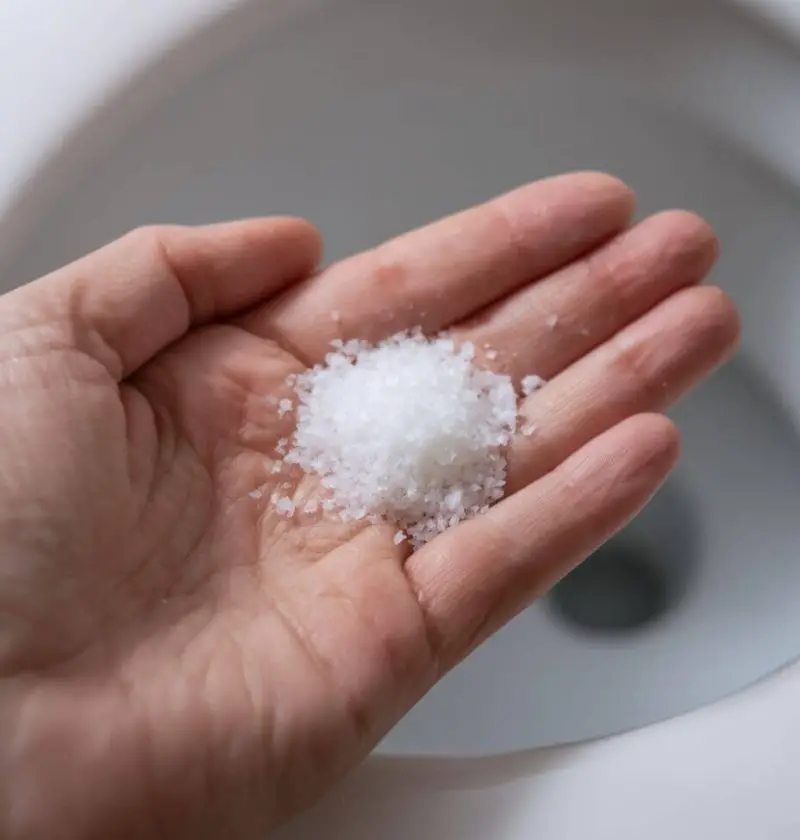Ever Heard of Pouring Salt in Your Toilet? Well, Plumbers Have—They Just Don’t Talk About It
Now, I know what you’re thinking. Salt? In the toilet? It sounds like one of those old wives’ tales your great-aunt might swear by—right alongside Vicks on your feet and baking soda in your fridge. But let me tell you: sometimes those little tricks are pure gold.
When it comes to plumbing, most of us are quick to call the pros at the first sign of trouble. And honestly, that’s usually the smart move. Plumbers have tools, know-how, and experience we just don’t. But every now and then, there’s a simple solution right under our noses—or in our pantry, in this case.
So, pull up a chair and pour yourself a cup of coffee. We’re about to get into why humble old salt might be your toilet’s new best friend.
Why Salt? Isn’t That Just for Dinner?
Good question. And yes, salt’s for seasoning your soup—but it’s also a surprisingly handy little helper in the bathroom. Here’s how:
1. Helps Keep Clogs at Bay
Salt’s texture is gritty, almost like a very gentle scrubber. When it’s swirled around in water, it can help break down small bits of waste or toilet paper before they clump up and cause a clog. It’s not going to snake your pipes (leave that to the pros), but it can definitely keep minor buildup from turning into a major headache.
If your household tends to be a little “flush-happy”—kids tossing too much paper, or older pipes that clog easily—this trick might just save you a weekend emergency call.
2. Fights Off Funky Smells
Here’s something folks don’t talk about enough: bathroom odors often come from moisture that just sits. That’s prime real estate for bacteria—and the smells that come with them. Salt naturally absorbs moisture and neutralizes certain compounds, so it helps keep things fresh without the chemical cloud of store-bought sprays.
Got a bathroom with no window? This one’s especially for you.
3. Scrubs Away Mineral Buildup
Hard water can be a real pain. It leaves those crusty white or brown lines around your toilet bowl that no amount of scrubbing seems to fix. Enter salt. Its abrasive texture helps loosen mineral deposits—especially when you let it sit a bit before giving it a good scrub with a toilet brush.
Think of it like exfoliating… but for porcelain.
4. Cheap as Chips
Look, we all love a sparkling clean toilet—but who wants to spend $8 on a cleaner full of chemicals you can’t pronounce? Salt is affordable, already in your kitchen, and doesn’t come with a warning label. Win-win.
You’ll also use less commercial cleaner overall if you make this a routine, and those savings add up more than you’d think.
5. A Friend to the Environment
Every time we flush harsh chemicals down the drain, they end up somewhere—usually in our waterways. Salt is natural, gentle, and doesn’t mess with aquatic life. It’s not going to single-handedly save the planet, but hey, every little bit helps.
Okay, But How Do You Actually Use Salt in a Toilet?
Easy-peasy. No gloves or goggles needed.
-
Grab a cup of table salt—plain old iodized salt works fine, though coarse kosher salt has a bit more scrubbing power if you’ve got it.
Save This Recipe
-
Pour it straight into the toilet bowl.
-
Let it sit—at least 15 minutes, but if you’re headed to bed, leaving it overnight works even better.
-
Grab your toilet brush and give the bowl a good scrub, focusing on mineral rings or problem spots.
-
Flush and watch that bowl sparkle.
Do this every couple of weeks and you’ll be amazed at how much cleaner (and fresher) things feel.
Why Plumbers Don’t Exactly Shout This From the Rooftops
Now, you might be wondering: “If this is so great, why hasn’t my plumber told me?” Well… let’s just say, there are a few reasons.
Job Security
Let’s not sugarcoat it—if everyone kept their toilets squeaky clean and clog-free, plumbers might get fewer calls. And while that doesn’t mean they’re hiding secrets, it’s not exactly in their best interest to hand out DIY tricks like Halloween candy.
Some Problems Still Need Pros
To be fair, salt isn’t going to fix a blocked sewer line or a cracked flange. Plumbers deal with the tough stuff—tree roots in pipes, busted valves, mystery leaks. So they tend to focus on those solutions, not pantry hacks.
Covering Their Bases
If a plumber tells you to use a home remedy and something goes wrong (like someone pours boiling salt water down a PVC pipe—please don’t do that), they’re on the hook. So many steer clear of recommending anything outside the official toolkit.
A Little Salt, A Lot of Savings
You know what I love most about this trick? It’s simple. It’s not fancy, it’s not expensive, and it doesn’t involve a 12-step process with tools you’ve never heard of. It’s just salt.
And honestly, I think we could all use more of these low-effort, high-reward wins in our home maintenance routines. Especially in places like the bathroom, where most of us would rather spend less time scrubbing and more time soaking in a hot bath.
So next time you’re tidying up, reach for the salt. Your toilet—and maybe your plumber’s calendar—will thank you.
A Final Word from This (Seasoned) Writer
Look, I’m no plumber. I’m just a 50-something who’s cleaned more toilets than I’d care to count—and who’s picked up a trick or two along the way. This one works. And even if it only buys you a few months between plumber visits, that’s money well saved and stress well dodged.
Got any homegrown cleaning tricks of your own? Shoot me a message—I’d love to hear them. Let’s keep those secrets flowing, shall we?

